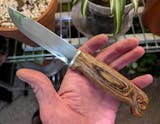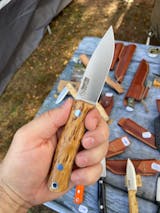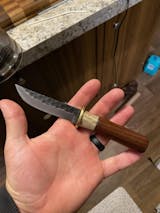Spoon Carving Beyond the Basics: Advanced Techniques and Wood Selection
If you’ve been drawn into the meditative world of spoon carving, you already know its appeal — the rhythm of the blade, the scent of fresh wood, and the deep satisfaction of shaping a simple branch into something beautiful and functional.
But once you've mastered the basics of carving a spoon blank and hollowing out the bowl, what comes next?
At Ragweed Forge, we support makers at every stage of their journey. Whether you're exploring advanced spoon carving techniques or choosing the best wood for carving, this guide is here to help you refine your craft and take it to the next level.
1. Refining Form: Advanced Spoon Carving Techniques
Shape and Geometry
-
Bowl Geometry: Move beyond simple scooping. Try thinner bowl walls, sharper shoulders, and smooth transitions between bowl and handle. These adjustments improve both aesthetics and functionality.
-
Handle Ergonomics: A good spoon should feel natural in the hand. Experiment with crank angles, thumb rests, faceted grips, and flowing curves for both beauty and comfort.
Decorative Detailing
-
Faceting: Highlight the blade’s path with clean, intentional knife marks — no sanding needed.
-
Chip Carving: Use a fine detail knife to carve geometric patterns into the handle.
-
Kolrosing: Incise delicate lines and fill them with coffee grounds or pigment to add contrast and texture.
-
Natural Finishes: Try milk paint or food-safe oils to add subtle color while protecting the wood and preserving grain character.
These advanced techniques require razor-sharp tools — especially your hook knife — to create clean, precise cuts with minimal tear-out.
2. Choosing the Right Wood for Advanced Spoon Carving
The wood species you select influences everything from how your knife moves through the grain to the durability and aesthetics of your finished spoon.
Green Wood vs. Dry Wood
-
Green Wood: Easier to carve, holds fine detail, and adds a bit of natural movement (warp) as it dries — often desirable for rustic character.
-
Dry Wood: More difficult to carve but produces more stable and durable spoons with less post-carving movement. Demands sharper tools and more control.
Top Wood Species for Spoon Carving
| Wood Type | Characteristics |
|---|---|
| Birch | Beginner-friendly, easy to carve green, subtle grain, finishes beautifully |
| Cherry | Smooth to carve, darkens with age, strong and elegant |
| Maple | Dense and durable, ideal for chip carving or kolrosing |
| Basswood (Linden) | Extremely soft, perfect for detail carving, but less durable for kitchen use |
| Willow & Alder | Soft and forgiving, often used for practice or decorative spoons |
| Fruitwoods (Apple, Pear, Plum) | Dense, aromatic, striking grain patterns, makes durable heirloom spoons |
Understanding the traits of each wood will help you select the right material for each project — whether you're aiming for decorative beauty, maximum durability, or both.
3. Sharpening for Precision: Essential for Advanced Work
As your skills evolve, sharpening becomes a craft in itself. The finer your work, the more critical it is to maintain a truly polished, razor-sharp edge.
Sharpening Essentials:
-
Use a progressive grit stone system to refine edges gradually.
-
Finish with a leather strop and compound to polish the bevel and remove burrs.
-
For hook knives, consider a dedicated hook knife strop to reach the inside curve.
Sharp tools mean:
-
Cleaner cuts
-
Less fatigue
-
Greater control for fine detail
👉 Check out our sharpening guide if you're ready to level up your edge.
4. Expanding Your Tool Kit: What Advanced Carvers Use
Your first carving knife and hook knife will serve you well — but as your techniques advance, additional tools unlock new possibilities.
Tools to Consider:
-
Carving Axes: Great for roughing out blanks efficiently without dulling your detail knives.
-
Detail Knives: For chip carving, kolrosing, and delicate finishing touches.
-
Hook Knives with Varied Sweeps: Broader curves for deep bowls, tighter curves for finishing or tricky grain.
-
Fine Sharpening Gear: Specialized stones and stropping tools help maintain high-performance edges on specialty blades.
At Ragweed Forge, we stock professional-grade carving tools trusted by experienced carvers — including precision blades from Mora and carving axes from Gransfors Bruk.
A Craft Without Limits
Spoon carving offers endless room for exploration. With the right techniques, thoughtful wood choices, and well-maintained tools, you’ll elevate your carving from functional to exceptional.
Whether you're exploring kolrosing for the first time or carving your tenth cherrywood spoon, the learning never stops.
Ready to deepen your carving skills?
👉 Browse our collection of advanced carving tools and hook knives to find your next favorite tool.






1 comment
Bill Anderson
I saw under the spoon carving info that it mentioned that you stock Gransfors Bruk carving axes. I did a search but couldn’t find them on your site. Thanks